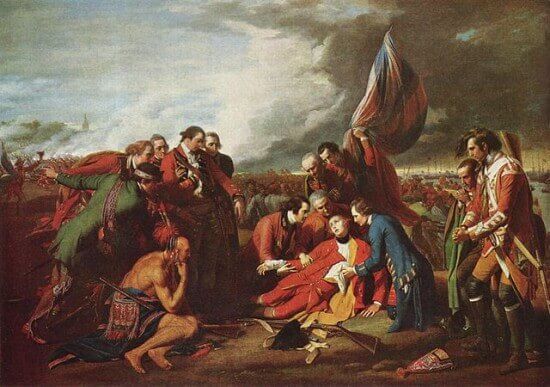
This painting, by Anglo-American artist Benjamin West in 1770, depicts the death of British General James Wolfe during the 1759 Battle of Quebec of the Seven Years’ War.
The French and Indian war is a very important war in early American History, before the United States were formed. The war is often misunderstood, and many people have facts about the war wrong. Here, we take a closer look at what really happened.
1. Who was fighting?
The French and Indian War does not mean the French were fighting the Indians. The French and some Native Americans were actually allies against the British Colonies, and Great Britain. Some other Native Americans allied with the British, so there were Indians on both sides. Spain also allied with France, toward the end of the war.
2. What’s in a name?
The name French and Indian War is not only deceptive in whom was fighting, but it isn’t even the name the whole world uses. British citizens refer to it as the French and Indian War, but those in other parts of the world call it the Seven Year War, or consider it as a part of the Seven Years’ War and do not give it a separate name. Some French Canadians call it the War of Conquest. The French and Indian War refers specifically to the North American involvement in the war.
3. When was the war?
The war took place from 1754 until 1763. Great Britain and France officially declared war against one another in 1756, which peaked the conflict. Although the war officially continued until 1763, the fighting in North America came to a stop around 1760. The remainder of the war was, for the most part, between the home countries.
4. Why were they fighting?
Great Britain and France were fighting over North America. They both wanted to dominate the colonies in North America, India, and the Caribbean. The more new land, the better!
5. George Washington fought
The French and Indian War was the first war George Washington fought in. He gained most of his military know how from the war, which lead to him leading the army in the revolution. If he had not fought in the French and Indian War, he probably would not have become president, or even famous.
6. A new way of fighting
Up until this war, the British had always fought in open fields, lined up. They would march and fire toward each other. The Indians taught the French a new way to fight. This involved camouflage and hiding out of sight. This tactic caused many British casualties, as they were not expecting such a maneuver.
7. Leaders and Battles
The first leader of the British Militia was General Braddock. He was killed in the line of duty. When William Pitt became the British secretary of state, more funds were dedicated to the war, allowing the British to gain an edge over France. The Battle of The Plains of Abraham led to the British occupation of Quebec. Next they captured Montreal, and essentially ended the fighting in North America in 1960. After 1960, one fort would be captured by France and later reclaimed by Britain, but overall, the fighting was done.
8. The end of the war
Fighting mostly ended in North America in 1760, although the war continued on until 1763. Great Britain won the war. The end of the war was also the end of French settlement in to colonies. After the war, Great Britain dominated settlement.
9. Treaty
The war ended with the Treaty of Paris on February 10th, 1763. The treaty gave most land to Britain. They gained Florida from Spain, and all of the French territories east of the Mississippi river, including most of Canada.
10. Continuing Results
Although the British won, the colonies were left with a lot of debt. This debt led to the taxation of the colonies, which eventually lead to the Revolutionary War and the forming of the United States of America.